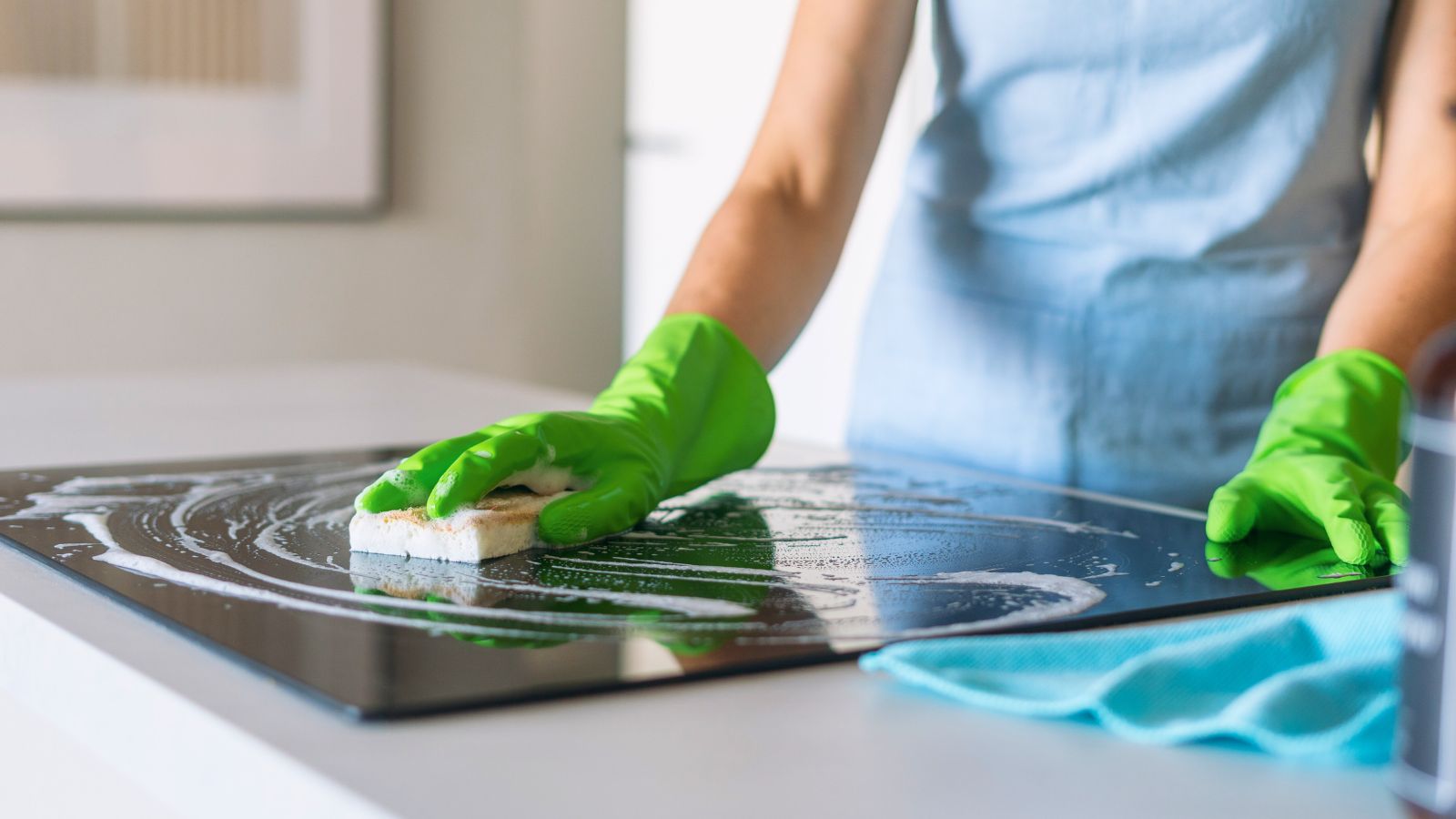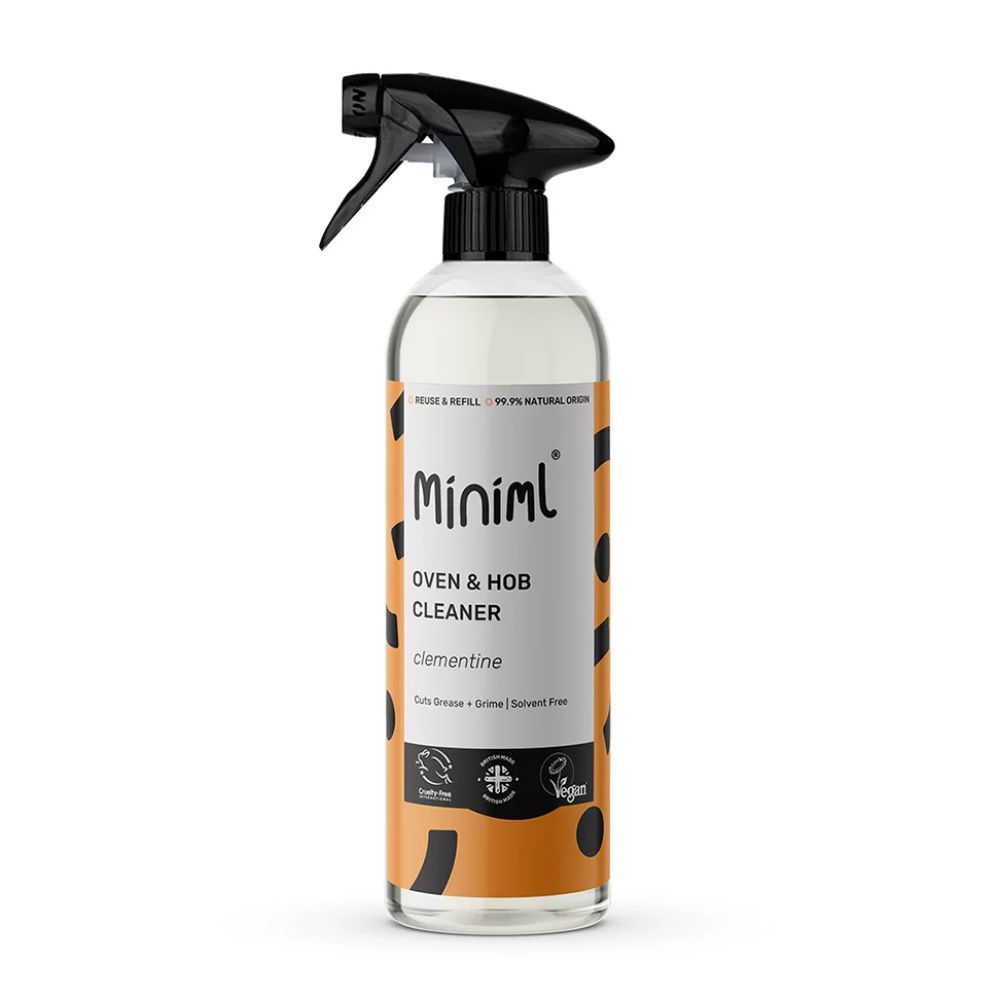How to clean an induction hob – follow these expert tips for a shiny, streak-free finish
Want to know how to clean an induction hob without scratching it? These easy expert tricks make it simple to keep that glossy finish looking brand new

Induction hobs may be some of the sleekest appliances you can add to modern kitchens, but that smooth glass surface is also famously unforgiving. Every splash of sauce and misty fingerprint shows up instantly, which is why understanding how to clean an induction hob properly is essential if you want to keep your workspace gleaming.
The secret to getting it right is using the right tools and techniques. A gentle cleaner, a soft cloth and a few smart habits make all the difference between a hob that stays show-home polished and one that starts to look tired far too soon.
Below, we break down the expert-approved methods that keep an induction hob clean, protected and performing exactly as it should, without scratching the glass or fading the controls.
Why do induction hobs need specific care?
Because induction technology heats the pan rather than the glass, spills don’t burn away — they simply sit on the hob’s surface. That makes day-to-day cleaning easier, but it also means residue can linger and quickly dull their shine if it’s not wiped away. And unlike metal gas burners, the glass top of an induction hob is more vulnerable to scratches, etching and faded control markings, so it needs a gentler touch.
As Sarah Whitfield, product manager at Stoves, explains: “Not only is it nicer to cook in a tidy kitchen, but keeping your induction hob clean can even save on energy use, as burnt food prevents the pan heating as efficiently.”
It also seems most of us instinctively understand the value of keeping these surfaces pristine. A recent survey by Domestic & General revealed that 25% of people wipe their hob every single day, and that the hob ranks as one of the cleanest items in the home, with just 1% of people admitting to never cleaning theirs.
But even with good habits in place, the trick is knowing exactly how to clean an induction hob without scratching the glass or damaging the control markings – and choosing the right tools makes all the difference.
Bring your dream home to life with expert advice, how to guides and design inspiration. Sign up for our newsletter and get two free tickets to a Homebuilding & Renovating Show near you.

Sarah Whitfield is a product manager at Glen Dimplex Home Appliances, offering expert insight into hob care, surface protection and appliance performance.

Ian Palmer-Smith is an appliance expert at Domestic & General, specialising in household appliance performance, longevity and maintenance. He provides practical, research-led guidance to help homeowners keep their ovens and hobs in top condition.
Tools and products you will need
You don’t need a cupboard full of specialist cleaning products to get this job done; just a few gentle, hob-friendly tools.
For everyday cleaning
- Microfibre cloths: ideal for wiping, drying and buffing without leaving streaks.
- Warm water and washing-up liquid: perfect for loosening light grime and day-to-day splatters.
- White vinegar in a spray bottle: great for cutting through cloudiness and restoring that glassy shine.
For deeper cleans
- A non-scratch sponge: gentle enough for glass, effective enough for greasy patches.
- Hob cream cleaner: helps lift stubborn marks without damaging the surface.
- A glass hob scraper: or, in a pinch, a plastic loyalty card, for safely removing cooked-on residue.
- A separate soft cloth for buffing: this is the secret to a streak-free finish.
What not to use on an induction hob
"If you wouldn’t use it on your phone screen, don’t use it on your hob," cautions Luke Arnel-Cameron, managing director of Yass Clean. "That means no abrasive scouring pads, no steel wool, and no harsh chemicals like bleach or ammonia, all of which can scratch, dull or mark the glass and the control symbols."
If you’re using a cleaning spray or cream cleaner, Luke also recommends popping on a pair of gloves and to avoid getting product directly on the control markings.
Shop cleaning supplies
How to clean an induction hob: A step-by-step Guide

Cleaning an induction hob doesn’t require a heavy hand. Just a light touch and a bit of consistency should do the trick. These are the simple steps that experts recommend:
- Make sure the hob is completely cool
Induction hobs cool quickly, but it’s still best to give the surface a moment to cool down. Switch it off at the mains if possible. - Start with a simple wipe-down
Use warm water and a little washing-up liquid with a microfibre cloth. This loosens everyday splatters from cooking and lifts any residue sitting on the glass. - Tackle light smears with vinegar
If the surface still looks cloudy, spritz a little diluted white vinegar and buff with a clean microfibre cloth. Sarah Whitfield notes that vinegar works brilliantly on glass-topped electric and induction hobs, helping bring back that sparkle without harsh chemicals. - Soak stubborn marks and let the cleaner do the work
If you’re dealing with cooked-on residue, avoid scrubbing right away. Instead, apply a hob cream cleaner and leave it to sit for 20–30 minutes. - Lift cooked-on bits with a scraper
Once the cleaner has softened the residue, use a glass hob scraper at a shallow angle to gently lift it off. Ian Palmer-Smith advises keeping the tool as horizontal as possible to avoid scratching. A old plastic loyalty card works in a pinch for very small patches. - Rinse and wipe clean
Use a soft, damp cloth to remove any leftover cleaner or residue. Avoid letting product pool around the control markings, as repeated contact can fade them over time. - Dry and buff for a streak-free shine
Finish with a fresh microfibre or glass cleaning cloth, buffing in light circular motions. A final mist of vinegar or a glass cleaner can help achieve that flawless, reflective finish.

Luke is the founder and managing director of Yass Clean, a brand born out of his viral TikTok presence. From there he used the momentum of TikTok Shop to turn the brand into a household cleaning name.
How often should you clean your induction hob?
“I always recommend giving your induction hob a quick wipe down after every use with a vinegar and water solution or hob cleaner," says Sarah Whitfield from Stoves. "That way, you can avoid burnt-on residue which builds up and becomes harder to clean. If it’s left too long, acidic foods such as fruits, tomatoes, and vinegars or salty or sugary foods can leave marks or dull spots and damage surfaces.”
Luke Arnel-Cameron agrees, adding: “The biggest mistake I see time and again is waiting too long. When you clean as you go, once the hob’s cool, you’ll never need to scrub hard."
“I tell customers: think of hob cleaning like brushing your teeth: quick daily care and a deeper clean weekly,” he advises. “After each use, a warm, soapy wipe-down prevents build-up. Once a week, take a few extra minutes to give the surface a proper polish. A monthly deep clean keeps everything sparkling and performing at its best.”
FAQs
Can you use vinegar or bicarbonate of soda on an induction hob?
It’s tempting to reach for natural cleaners, but they’re not always the best match for delicate glass surfaces. “Natural solutions such as white vinegar can help remove limescale but may leave streaks on glass surfaces,” cautions Sophie Lane, product training lead at Miele GB. “Likewise, bicarbonate of soda is mildly abrasive and should be avoided on ceramic or induction hobs to prevent scratching.”
These DIY cleaning methods can be fine for very light cleaning, but Sophie stresses that purpose-made products are the safer choice. “While these natural, DIY options can work for light cleaning, commercial hob cleaners are specially formulated to protect delicate surfaces and deliver a polished finish,” she adds.
Why do marks appear even after I’ve cleaned the hob?
Cloudy patches, streaks or dull spots usually mean that residue hasn’t been fully lifted or the surface hasn’t been dried completely. This can happen if cleaner is simply spread around rather than removed, or if water is left to evaporate on the glass. A dry microfibre cloth is perfect for the final step, as it helps pick up any lingering residue and restores a clear, polished finish.
How do you clean a gas hob?
Gas models require a little more dismantling than an induction or ceramic hob, but the cleaning process is still straightforward. Appliance expert Ian Palmer-Smith notes that the materials you need “depend on the type of hob you have and how dirty it is,” but for gas hobs specifically, warm soapy water, a gentle cleaning spray and soft cloths are the essentials.
Start by making sure the hob is fully cool, then lift off the burner caps and supports. Ian recommends a simple setup: “A bucket or sink of warm water with washing-up liquid, cleaning spray, two soft cloths, a toothbrush, and a soft-bristled scrubbing brush.” Soak the removable parts in warm, soapy water to loosen grease, then use the brush or toothbrush to get into the tricky areas around the burners"
Wipe the surface with a gentle cleaning spray and a soft cloth, avoiding anything abrasive. Once everything is clean and dry, reassemble the burners and give the hob a final buff.
Knowing how to keep a hob clean is just one part of achieving a truly spotless kitchen. Pairing it with a reliable cooker hood or kitchen extractor fan helps control steam, reduce residue and prevent mould from forming.

Gabriella is an interiors journalist and has a wealth of experience creating interiors and renovation content. She was Homebuilding & Renovating's former Assistant Editor as well as the former Head of Solved at sister brand Homes & Gardens, where she wrote and edited content addressing key renovation, DIY and interior questions.
She’s spent the past decade crafting copy for interiors publications, award-winning architects, and leading UK homeware brands. She also served as the Content Manager for the ethical homeware brand Nkuku.
Gabriella is a DIY enthusiast and a lover of all things interior design. She has a particular passion for historic buildings and listed properties, and she is currently in the process of renovating a Grade II-listed Victorian coach house in the West Country.



